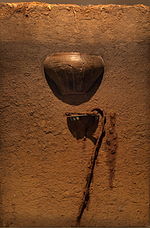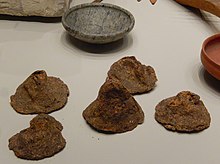Grave goods
This articleneeds additional citations forverification.(February 2008) |

Grave goods,inarchaeologyandanthropology,are items buried along with abody.
They are usually personal possessions, supplies to smooth the deceased's journey into anafterlife,or offerings togods.Grave goods may be classed by researchers as a type ofvotive deposit.Most grave goods recovered by archaeologists consist of inorganic objects such as pottery and stone and metal tools, but organic objects that have since decayed were also placed in ancient tombs.[1]If grave goods were to be useful to the deceased in the afterlife, then favorite foods or everyday objects were supplied. Oftentimes, social status played a role in what was left and how often it was left.[2]Funerary artis a broad term but generally means artworks made specifically to decorate a burial place, such as miniature models of possessions - including slaves or servants - for "use" in an afterlife. (Ancient Egypt sometimes saw the burial of real servants with the deceased.[3]Similar cases ofhuman sacrificeof slaves, retainers and wives feature in graves in (for example) the Americas, ancient Germania, and ancient Mesopotamia.[4]Comparesuttee.)
Where grave goods appear,grave robberyis a potential problem.Etruscanswould scratch the wordśuθina,Etruscanfor "from a tomb", on grave goods buried with the dead to discourage their reuse by the living.[5]The tomb ofpharaohTutankhamunis famous because it was one of the fewEgyptian tombsthat was not thoroughly looted in ancient times.
Grave goods can be regarded as asacrificeintended for the benefit of the deceased in theafterlife.Closely related are customs ofancestor worshipand offerings to the dead, in modern western culture related toAll Souls' Day(Day of the Dead), in East Asia the "hell bank note"and related customs.[6][7][8]Also closely related is the custom ofretainer sacrifice,where servants or wives of a deceased chieftain are interred with the body.[9]As the inclusion of expensive grave goods and of slaves or retainers became a sign of high status in theBronze Age,the prohibitive cost led to the development of "fake" grave goods, where artwork meant todepictgrave goods or retainers is produced for the burial and deposited in the grave in place of the actual sacrifice.[10]
History[edit]

There are disputed claims ofintentional burialofNeanderthalsas old as 130,000 years. Similar claims have been made for earlyanatomically modern humansas old as 100,000 years. The earliest undisputed cases ofhomo sapiensburials are found inUpper Palaeolithicsites.
Burials that include intentional artifacts come much later. There is evidence of Egyptians (of theBadarian culture) being buried with grave goods very early in their prehistory. Examples of these items include pots, shells, combs, stone vessels, animal figurines, and slate palettes.[11][12]
Beads made ofbasaltdeposited in graves in theFertile Crescent date to the end of theUpper Paleolithic,beginning in about the 12th to 11th millennium BC.[13]
The distribution of grave goods are a potential indicator of thesocial stratificationof a society. Thus, earlyNeolithicgraves tend to show equal distribution of goods, suggesting a more or lessclassless society,while inChalcolithicandBronze Ageburials, rich grave goods are concentrated in "chieftain"graves (barrows), indicating social stratification.[14]It is also possible that burial goods indicate a level of concern and consciousness in regard to anafterlifeand related sense ofspirituality.For example, when they buried pharaohs in ancient Egypt, they buried common house hold items, food, vehicles, etc. so they could have a comfortable afterlife.[15]
Famous grave sites[edit]

The expression of social status in rich graves is taken to extremes in the royal graves of the Bronze Age. In theTheban NecropolisinAncient Egypt,thepyramidsand the royal graves in theValley of the Kingsare among the most elaborate burials in human history. This trend is continued into theIron Age.An example of an extremely rich royal grave of the Iron Age is theTerracotta ArmyofQin Shi Huang.[16]
In the sphere of theRoman Empire,early Christiangraves lack grave goods, and grave goods tend to disappear with thedecline of Greco-Roman polytheismin the 5th and 6th centuries. Similarly, the presence of grave goods in theEarly Middle Agesin Europe has often been taken as evidence ofpaganism,although during the period of conversion inAnglo-Saxon Englandand theFrankish Empire(7th century), the situation may be more complicated.[17] In the Christian Middle Ages, high-status graves are marked on the exterior, withtomb effigiesor expensive tomb stones and still had certain grave goods such as accessories and textiles.[18]
The practice of placing grave goods with the dead body has thus an uninterrupted history beginning in theUpper Paleolithic,if not theMiddle Paleolithic.Many people would assume that the introduction of Christianity led to the absence of grave goods, however, there were many different Christian tombs that were shown to still have grave goods such as jewelry.[18][19]
Role in archaeology[edit]

The importance of grave goods, from the simple behavioral and technical to the metaphysical, inarchaeologycannot be overestimated. Because of their almost ubiquitous presence throughout the world and throughout prehistory, in many cases the excavation of every-day items placed in burials is the main source of such artifacts in a given prehistoric culture. However, care must be taken to avoid naïve interpretation of grave goods as an objective sample of artifacts in use in a culture. Because of their ritual context, grave goods may represent a special class of artifacts, in some instances produced especially for burial. Artwork produced for the burial itself is known asfunerary art,while grave goods in the narrow sense are items produced for actual use that are placed in the grave, but in practice the two categories overlap.
Grave goods in Bronze Age and Iron Age cemeteries are a good indicator of relativesocial status;these wealthier graves may have included earrings, necklaces, and exotic foreign materials such as amber. Some even had the spectacular sighting of gold as their grave goods which contrasted from the less wealthy graves which were more deficient.[20]Also, in a 2001 study on anIron Agecemetery inPontecagnano Faiano,Italy, a correlation was found between the quality of grave goods andForensicindicators on the skeletons, showing that skeletons in wealthy tombs tended to show substantially less evidence of biological stress during adulthood, with fewer broken bones or signs of hard labor.[21]
Along with social status, grave goods also shed light on the societal norms with regards to sex. Common binary societies had women perform duties such as mothering, processing activities, cooking, etc. and men perform duties such as hunting and fighting. These societies would bury their women with jewelry and their men with axes. TheDurankulakcemetery on theBulgarian Black Sea Coasthad findings to match this society structure.[22]There are societies where the roles are switched. TheSauromatiansociety's women were highly respected warriors. Their graves were full of weapons and horse trappings.[23]When it was difficult to determine sex of the individual due to bone decay, the grave goods became the determining factor.
In modern times[edit]
Grave goods continue to be important in modern funerary rituals. In contemporary English and American culture, bodies may be buried with goods such as eyewear, jewelry, photographs, and letters.[24]In addition, objects are sometimes left above ground near or on top of gravestones. Flowers are common, althoughvisitation stonesare preferred in Jewish culture.[25]In addition,coins for the dead(includingchallenge coins) are sometimes left on American military graves by comrades of the deceased.[26]
See also[edit]
- Burial
- Grave field
- Necropolis
- Mingqi,the traditional Chinese burial goods
References[edit]
- ^Ian Morris,Death-Ritual and Social Structure in Classical Antiquity(Cambridge, 1992;ISBN0-521-37611-4)
- ^"Grave Goods in Ancient Egypt".World History Encyclopedia.Retrieved2020-10-02.
- ^hooverre (2014-02-06)."Ancient Egyptian Grave Goods".Rise of Civilization.Archived fromthe originalon 2021-01-18.Retrieved2020-10-02.
- ^ Taylor, Timothy(2004).The Buried Soul: How Humans Invented Death.Beacon Press.ISBN9780807046722.Retrieved11 April2023.
- ^Giuliano BonfanteandLarissa BonfanteThe Etruscan Language: an Introduction(Univ. Manchester Press, 2002.ISBN0-7190-5540-7); several examples collected
- ^"All Souls' Day – Saints & Angels".Catholic Online.Retrieved2020-10-14.
- ^"Top 10 things to know about the Day of the Dead".Travel.2017-10-26. Archived fromthe originalon July 14, 2017.Retrieved2020-10-14.
- ^"What's the Origin of Hell Money?".South China Morning Post.2015-09-03.Retrieved2020-10-14.
- ^"Human Sacrifice | The Ancient Egypt Site".ancient-egypt.org.Retrieved2020-10-14.
- ^"BBC – History – Ancient History in depth: Hidden Treasure Fact Files".bbc.co.uk.Retrieved2020-10-14.
- ^"Artifacts: Grave Goods, Mummification, Online Exhibits, Exhibits, Spurlock Museum, U of I".spurlock.illinois.edu.Retrieved2020-11-12.
- ^Smith, Homer W.(2015) [1952].Man and His Gods.p. 16.
- ^The Earliest Beads, muma.org[clarification needed]
- ^see e.g. William A. Haviland, Harald E. L. Prins, Dana Walrath, Bunny McBride,Anthropology: The Human Challenge,Cengage Learning, 2010ISBN978-0-495-81084-1,p. 268.
- ^"Mummy History".history.Retrieved2020-11-12.
- ^Lubow, Arthur."Terra Cotta Soldiers on the March".Smithsonian Magazine.Retrieved2020-10-14.
- ^Helen Geake,The use of grave-goods in conversion-period England, c. 600–c. 850,British Archaeological Reports, 1997,ISBN978-0-86054-917-8
- ^abPleşa, Alexandra D. (2017)."Religious Belief in Burial: Funerary Dress and Practice at the Late Antique and Early Islamic Cemeteries at Matmar and Mostagedda, Egypt (Late Fourth–Early Ninth Centuries CE)".Ars Orientalis.47(20191029).doi:10.3998/ars.13441566.0047.002.hdl:2027/spo.13441566.0047.002.ISSN2328-1286.
- ^Bayliss, Alex (2017-07-05).Anglo-Saxon Graves and Grave Goods of the 6th and 7th Centuries AD.Routledge.doi:10.4324/9781315097220.ISBN978-1-315-09722-0.
- ^"BBC – History – Ancient History in depth: Hidden Treasure Fact Files".bbc.co.uk.Retrieved2020-11-12.
- ^Robb, John; Bigazzi, Renzo; Lazzarini, Luca; Scarsini, Caterina; Sonego, Fiorenza (2001). "Social status and biological status: A comparison of grave goods and skeletal indicators from Pontecagnano".American Journal of Physical Anthropology.115(3): 213–222.doi:10.1002/ajpa.1076.PMID11424073.
- ^Stratton, Susan (2016-08-11)."'Seek and you Shall Find.' How the Analysis of Gendered Patterns in Archaeology can Create False Binaries: a Case Study from Durankulak ".Journal of Archaeological Method and Theory.23(3): 854–869.doi:10.1007/s10816-016-9290-2.ISSN1072-5369.S2CID152224107.
- ^Guliaev, V. I. (April 2003)."Amazons in the Scythia: New finds at the Middle Don, Southern Russia".World Archaeology.35(1): 112–125.doi:10.1080/0043824032000078117.ISSN0043-8243.S2CID22946203.
- ^Harper, Sheila (2012)."'I'm glad she has her glasses on. That really makes the difference': Grave goods in English and American death rituals ".Journal of Material Culture.17(1): 43–59.doi:10.1177/1359183511432987.ISSN1359-1835.
- ^adventuresincemeteryhopping (2013-12-13)."Grieving Outside the Box: Why People Leave Things on Graves".Adventures in Cemetery Hopping.Retrieved2024-07-12.
- ^Swanson, Christa (May 27, 2024)."Coins on a soldier's headstone: What do they mean?".fox4kc.RetrievedJuly 12,2024.
Further reading[edit]
- Härke, Heinrich (2014). "Grave goods in early medieval burials: messages and meanings".Mortality.19(1): 41–60.doi:10.1080/13576275.2013.870544.ISSN1357-6275.S2CID143771175.
- Huggett, J. W. (1988)."Imported Grave Goods and the Early Anglo-Saxon Economy".Medieval Archaeology.32:63–96.doi:10.5284/1071745.
- Woodward, Ann; Hunter, John; Ixer, Rob; Maltby, Mark; Potts, Philip J.; Webb, Peter C.; Watson, John S.; Jones, Michael C. (2005). "Ritual in Some Early Bronze Age Gravegoods".Archaeological Journal.162:31–64.doi:10.1080/00665983.2005.11020620.S2CID162333049.
